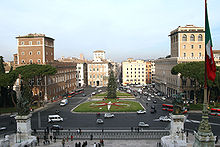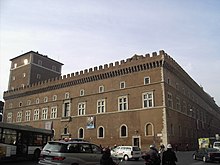Palazzo Venezia
The Palazzo Venezia , Palazzo di Venezia or Palazzo Barbo is a palace located on the Piazza Venezia in Rome . The palace houses the Museo di Palazzo Venezia , the National Art Library ( Biblioteca di Archeologia e Storia dell'Arte ) , the National Institute of Archeology and Art History ( Istituto Nazionale di Archeologia e Storia dell'Arte ) and the directorate of the state museums in the region Lazio .
history
The Venetian Cardinal Pietro Barbo had a smaller palace next to the Church of San Marco , his titular church , expanded in 1455 with a new building, which was completed in 1467. In 1464 Barbo was elected Pope as Paul II . First he moved his papal residence here, but moved back to the Vatican in 1470.
The palace subsequently passed into the hands of his nephew, Cardinal Marco Barbo. From 1567 to 1797 the palace was owned by the Republic of Venice under the name Palazzo San Marco and served as the official residence of the Venetian ambassador to the Holy See . During this time the palace hosted a number of illustrious guests, such as Borso d'Este , Duke of Ferrara and the French King Charles VIII. Emperor Charles V met here with Pope Paul III. Farnese and agreed with him to convene the Council of Trent . Pope Clement VIII headed the last consistory he convened here in 1597 .
With the Peace of Campo Formio (1797), the Roman Palace of the Serenissima also came into Austrian ownership. During Napoleon's brief domination over Italy between 1806 and 1814, the palace fell into disrepair and the inner courtyard was used as a market until it came under the care of the French museum administration during the restoration period . The Austrian owners returned in 1814 and the palace was temporarily used as an embassy, which was soon relocated due to the dilapidation of the building. The building was then restored under the direction of the Viennese architect Anton Barvitius . In 1916, the year of the war, the Palazzo was confiscated by the Italian state. The contractual regulation with the states of Austria and Hungary took place from 1919.
Until 1943 it was the seat of government of Mussolini , who gave his speeches to the Romans from the balcony of the palace and, among other things, proclaimed Italy's entry into the war against France and Great Britain in 1940.
architecture
The palace has undergone serious changes over and over again during its complex and long building history. The original cardinal palace with its mighty tower over a square floor plan and the adjoining palace corresponded to the building type common at that time for Roman city palaces.

Giuliano da Maiano , Batolomeo Bellano and Bernardo Rosselino are presumed to be responsible for the subsequent alterations and extensions as a papal residence . The palace shares the hypothesis that Alberti was also involved in the concept with other Roman buildings of the time, but there is no evidence of this. In recent literature, Francesco da San Sepolcro is named as the master builder. First, the area of the old Cardinal Palace was expanded from around 700 m² to 11,000 m², including the creation of a garden that could be viewed from the papal apartments. It was bordered by a loggia crowned with battlements, which was added a little later by another.
The present exposed location of the palace only resulted from the redesign of the Piazza Venezia in the course of the erection of the monumental national monument for Victor Emanuel II , which was carried out between 1885 and 1911 and which were demolished for the parts of the old neighboring buildings. From 1911 the building of the insurance company Assicurazioni Generali was built as a counterpart to the Palazzo Venezia , also equipped with a mighty tower and battlements and a portal, which, like that of the palazzo, is crowned with the winged St. Mark's lion.
The broad front with the old crenellated corner tower dominates the Piazza Venezia. The north side of the palace extends along Via del Plebiscito , on the west side the palace area with the garden behind it is delimited solely by a wall with a battlement. On the south side is the church of San Marco , which was included in the complex when the palazzo was built.
The palazzo is considered to be the first large building of the early Renaissance in Rome . Its brownish facade, adorned by three rows of white marble windows , with a crenellated crown gives it a medieval character. The windows on the upper floor are shaped like the Guelph cross. The real aspect of the Renaissance can only be seen in the courtyard loggia . The column order of the Colosseum , a typical feature of the reception of antiquities , was adopted there.
Mussolini's air raid shelter is located under the palazzo at a depth of 16 m.
The museum
Since the middle of the 15th century, ancient statues from the possession of Cardinal Barbos, who was an avid collector of ancient finds, were exhibited in the palazzo. Most of the antiquities were probably transferred to the Castel Sant'Angelo by Barbo's successor Sixtus IV after his death ; their further whereabouts can no longer be proven. In 1503, however, with the appointment of Domenico Grimani, a new collection of antiquities began in the palazzo. Grimani, one of the most important art collectors and patrons of the Renaissance, set up a first-rate collection in the palace. After his death in 1523, the Serenissima seized the inheritance, which was partially returned to the legitimate Grimani heirs only after legal disputes with the republic. Some pieces reached the Vatican in the second half of the 16th century. Finally, at the end of the 18th century, the last antiquities were brought to Venice at the instigation of the Venetian ambassador.
In addition to examples from its lapidary, the museum shows an important collection of weapons, a collection of tapestries, coins and medals, fabrics, glasses, enamel work, and a collection of silver work and wood carvings. Noteworthy are Gianlorenzo Bernini's memory of Sister Maria Raggi and the portrait bust of Pope Paul II by Paolo Romano (fig.)
The painting collection includes pictures from the 13th to 18th centuries. Century, including Filippo Lippi's “ Annunciation with Donors ” and works by Carlo Maratta , Guercino , Guido Reni , Domenichino , Giorgione and Giotto .
literature
- Anton Barvitius : Report on the existing buildings of the KK embassy hotel in Rome called il Palazzo di Venezia. With a history of the palace as an introduction to the report , Rome 1858 ( digitized version )
- Centro Stampa Editoriale (ed.): Rome and the Vatican . Casa Editrice Perseus, ISBN 88-7280-521-X .
- Maria Giulia Barberini, Giulia Quintiliani, Filippo Raimondo: Palazzo Venezia, il Palazetto e il suo lapidarium . Roma 2006.
Web links
- Palazzo Venezia. In: arch INFORM .
- Official site (Italian / English)
Individual evidence
- ↑ Article 37 of the Treaty of Trianon reads: Italy does not have to make any payment from the title of taking possession of the "Palazzo Venetia" in Rome. ( Receipt )
- ↑ State Treaty of St. Germain, Article 40. Federal Chancellery of the Republic of Austria, September 10, 1919, accessed on May 1, 2016 .
- ↑ Barberini, Maria Giulia: Le origini: La dimora privata del cardinale Pietro Barbo e il palazzo di Paolo II in: Palazzo Venezia, il Palazetto e il suo lapidario. Roma 2006. p. 17.
- ↑ Mussolini's secret bunker fortresses deciphered ( memento from October 26, 2014 in the Internet Archive )
- ↑ Paul Badde: Rome: How does fresh air get into the bunker of the "Duce"? In: welt.de . March 28, 2013, accessed October 7, 2018 .
Coordinates: 41 ° 53 ′ 46.3 " N , 12 ° 28 ′ 53.6" E



